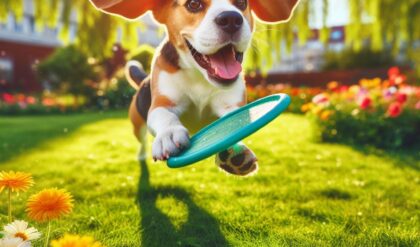Introductory Paragraph: Training a beagle puppy to sit without treats can be a rewarding and effective approach to building a strong bond with your furry companion. While treats are commonly used as a training aid, it’s essential to recognize that positive reinforcement can come in various forms, such as praise, affection, and play. By incorporating these alternative reinforcements, you can teach your beagle puppy the sit command without relying solely on food rewards. This approach not only promotes a healthier relationship but also fosters a deeper understanding and obedience between you and your pup.

Establish a Positive Reinforcement Mindset
Positive reinforcement is a fundamental principle in training dogs, and it involves rewarding desired behaviors to encourage their repetition. When training your beagle puppy to sit without treats, it’s crucial to adopt a positive mindset and approach the process with patience and consistency. Recognize that puppies have a natural inclination to please their owners and respond positively to praise and affection.
The Power of Praise and Affection
Praise and affection can be powerful motivators for your beagle puppy. When your pup sits on command, shower them with verbal praise, gentle petting, and enthusiastic body language. This positive reinforcement will help your puppy associate the desired behavior with a rewarding experience, encouraging them to repeat the action.
Building Trust and Bonding
Training your beagle puppy without treats presents an opportunity to strengthen the bond between you and your furry friend. By focusing on praise and affection, you create a positive and nurturing environment that fosters trust and communication. This bond will not only facilitate the training process but also contribute to a deeper and more meaningful relationship with your pup.
Consistency is Key
Consistency is crucial when training your beagle puppy without treats. Establish a clear and consistent command for the sit behavior, such as “sit,” and use the same tone and body language each time. Consistency will help your puppy understand what is expected of them and reinforce the desired behavior.
Mastering the Sit Command
Teaching your beagle puppy to sit without treats involves a step-by-step approach and patience. Here’s how you can effectively master the sit command:
Capturing the Sit Behavior
One effective technique is to capture the sit behavior when your puppy naturally sits down. As soon as their bottom touches the ground, praise and reward them with affection. This reinforces the connection between the behavior and the positive reinforcement.
Luring with a Toy or Hand Signal
Instead of using treats, you can lure your puppy into the sitting position by holding a toy or using a hand signal. When your pup follows the lure and sits, immediately praise and reward them with affection or a brief play session with the toy.
Gradually Introducing the Command
Once your puppy consistently sits in response to the lure or hand signal, gradually introduce the verbal command “sit.” Pair the command with the lure or hand signal, and as your puppy sits, praise and reward them. Over time, phase out the lure or hand signal, relying solely on the verbal command.
Incorporating Interactive Play
Interactive play can be an effective way to reinforce the sit command and create a positive association with the behavior. Here’s how you can incorporate play into your training sessions:
Play as a Reward
Instead of treats, use interactive play as a reward for your beagle puppy when they successfully sit on command. This could involve a brief game of tug-of-war, fetch, or simply engaging in playful petting and praise.
Combining Sit and Play
Incorporate the sit command into your playtime routine. For example, ask your puppy to sit before throwing a ball or engaging in a game of chase. This reinforces the sit command while also creating a positive association with the behavior.
Keeping It Fun and Engaging
Training sessions should be brief and fun for your beagle puppy. Puppies have short attention spans, so aim for 5-10 minute sessions and keep the atmosphere positive and engaging. Incorporate a variety of interactive games and activities to keep your pup motivated and interested.
Building Reliability and Duration
As your beagle puppy becomes proficient in sitting on command without treats, you can gradually increase the difficulty and duration of the behavior. This will help reinforce the sit command and build reliability.
Increasing Duration
Start by asking your puppy to sit for a few seconds, and gradually extend the duration as they become more consistent. Praise and reward them for maintaining the sit position for longer periods.
Adding Distractions
Introduce distractions during training sessions, such as toys or sounds, to test your puppy’s ability to focus and maintain the sit command. This will help prepare them for real-world situations and reinforce the reliability of the behavior.
Varying Locations and Environments
Practice the sit command in different locations and environments to ensure your beagle puppy can generalize the behavior. This could include training in different rooms, outdoors, or in public spaces with minimal distractions.
Consistency and Patience
Training a beagle puppy to sit without treats requires patience and consistency. Here are some additional tips to keep in mind:
Consistency in Training Approach
Consistency is crucial in training. Ensure that all family members use the same command, reward system, and training techniques to avoid confusing your puppy.
Patience and Positive Reinforcement
Puppies learn at their own pace, and it’s essential to be patient and consistent throughout the training process. Maintain a positive and encouraging attitude, and always reinforce desired behaviors with praise and affection.
Regular Practice Sessions
Regular practice sessions are essential for reinforcing the sit command. Aim for multiple short training sessions throughout the day, and incorporate the sit command into your daily routine, such as before meals or playtime.
Conclusion
Training a beagle puppy to sit without treats is an achievable and rewarding endeavor. By focusing on positive reinforcement through praise, affection, and interactive play, you can create a strong bond with your furry companion while teaching them a reliable sit command. Remember to be patient, consistent, and creative in your approach, and celebrate each milestone as your puppy progresses. With dedication and a positive mindset, you can successfully train your beagle puppy to sit without relying on treats, fostering a deeper connection and obedience that will last a lifetime.
Training a Beagle Puppy Without Treats: A Comprehensive Guide
Training a beagle puppy without treats presents a unique opportunity to strengthen the bond between you and your furry friend. By focusing on praise, affection, and interactive play, you can effectively teach your puppy essential commands while fostering trust and communication. In this comprehensive guide, we will explore the key strategies and techniques for training your beagle puppy without the use of treats.
Establishing a Training Routine
Establishing a consistent training routine is essential when teaching your beagle puppy without treats. A structured approach will help your puppy understand what is expected of them and create a positive learning environment. Here are some key steps to consider when establishing a training routine:
Setting Clear Goals
Before you begin training your beagle puppy, it’s important to set clear goals and objectives. Determine what behaviors you want to teach your puppy and establish a timeline for achieving these goals. Whether you’re focusing on basic commands like sit and stay or more advanced behaviors, having a clear plan in place will help guide your training sessions.
Creating a Training Schedule
Consistency is key when training a puppy, so it’s essential to create a regular training schedule. Aim for short, frequent training sessions throughout the day to keep your puppy engaged and prevent them from becoming overwhelmed. Incorporate training into your daily routine, such as before meals or walks, to reinforce good behavior consistently.
Designating a Training Area
Designating a specific area for training can help minimize distractions and create a focused environment for you and your puppy. Choose a quiet, well-lit space in your home where you can conduct training sessions without interruptions. Having a dedicated training area will signal to your puppy that it’s time to focus and learn.
Using Positive Reinforcement
Positive reinforcement is a powerful training tool that can help motivate your puppy and reinforce good behavior. Instead of relying on treats, use praise, affection, and interactive play to reward your puppy for following commands correctly. Positive reinforcement creates a positive association with training and strengthens the bond between you and your puppy.
Tracking Progress
Tracking your puppy’s progress is essential for monitoring their development and adjusting your training approach as needed. Keep a training journal or log to record your puppy’s achievements, setbacks, and areas for improvement. Tracking progress will help you identify patterns, celebrate milestones, and make informed decisions about your training strategy.
Teaching Basic Commands
Teaching your beagle puppy basic commands is an important part of their training and socialization. Commands like sit, stay, come, and heel are essential for communicating with your puppy and keeping them safe in various situations. Here are some tips for teaching basic commands without using treats:
Focus on Verbal Cues
When teaching basic commands, such as sit or stay, focus on using clear and consistent verbal cues. Choose simple, one-word commands that are easy for your puppy to understand, such as “sit” or “stay.” Pair each command with a hand signal or gesture to reinforce the desired behavior.
Practice Regularly
Consistent practice is key to mastering basic commands with your beagle puppy. Incorporate short training sessions into your daily routine to reinforce commands and provide opportunities for your puppy to practice. Repetition and consistency will help your puppy learn and retain new behaviors effectively.
Use Play as a Reward
Instead of treats, use interactive play as a reward for your puppy’s good behavior during training sessions. Engage in games like tug-of-war, fetch, or hide-and-seek to reinforce commands and provide mental stimulation. Playtime not only rewards your puppy but also strengthens your bond and enhances their overall well-being.
Be Patient and Consistent
Training a puppy requires patience, consistency, and a positive attitude. Be patient with your puppy as they learn new commands and behaviors, and avoid getting frustrated if progress is slow. Consistency in your training approach will help your puppy understand what is expected of them and build confidence in their abilities.
Seek Professional Guidance
If you’re struggling to teach your beagle puppy basic commands without treats, don’t hesitate to seek professional guidance. A certified dog trainer or behaviorist can provide personalized advice, tips, and techniques to help you overcome training challenges and achieve your goals. Professional guidance can be especially beneficial for addressing specific behavioral issues or advanced training needs.
Addressing Behavioral Challenges
Training a beagle puppy without treats may present certain challenges, especially when dealing with behavioral issues or stubborn tendencies. It’s important to approach training with patience, understanding, and a proactive mindset to address challenges effectively. Here are some common behavioral challenges you may encounter and strategies for overcoming them:
Jumping Up
Beagle puppies are known for their exuberant nature and may have a tendency to jump up on people in excitement. To address jumping up, ignore the behavior and turn away from your puppy when they jump. Only give attention and affection when your puppy has all four paws on the ground. Redirect their energy into a more appropriate behavior, such as sitting or offering a toy.
Pulling on the Leash
Walking nicely on a leash is a skill that takes time and patience to master. If your beagle puppy pulls on the leash during walks, stop walking and wait for them to relax before continuing. Use positive reinforcement, such as praise and affection, when your puppy walks calmly by your side. Consider using a front-clip harness or head halter to discourage pulling and provide better control during walks.
Excessive Barking
Beagles are known for their vocal nature and may bark excessively in response to various stimuli. To address excessive barking, identify the triggers that cause your puppy to bark and work on desensitizing them through counterconditioning. Teach your puppy alternative behaviors, such as “quiet” or “speak,” to redirect their barking into more controlled responses. Provide mental and physical enrichment to prevent boredom and reduce excessive barking.
Destructive Chewing
Chewing is a natural behavior for puppies, but it can become destructive if left unchecked. To prevent destructive chewing, provide your puppy with appropriate chew toys and rotate them regularly to keep things interesting. Supervise your puppy closely and redirect their chewing onto acceptable items. Use bitter apple spray or deterrents on furniture or belongings to discourage inappropriate chewing behavior.
Separation Anxiety
Beagles are social dogs that thrive on human companionship, which can sometimes lead to separation anxiety when left alone. To address separation anxiety, gradually acclimate your puppy to being alone through short absences and positive reinforcement. Create a comfortable and secure environment for your puppy when you’re away, with plenty of toys, treats, and comforting items. Consider crate training as a safe space for your puppy to relax and feel secure in your absence.
Conclusion
Training a beagle puppy without treats requires patience, consistency, and a deep understanding of your puppy’s behavior and learning style. By focusing on positive reinforcement, clear communication, and interactive play, you can effectively teach your puppy essential commands and address behavioral challenges. Remember to approach training with a positive attitude, celebrate small victories, and seek professional guidance when needed. With dedication and a strong bond built on trust and communication, you can successfully train your beagle puppy without treats and enjoy a lifelong partnership filled with love and companionship.






